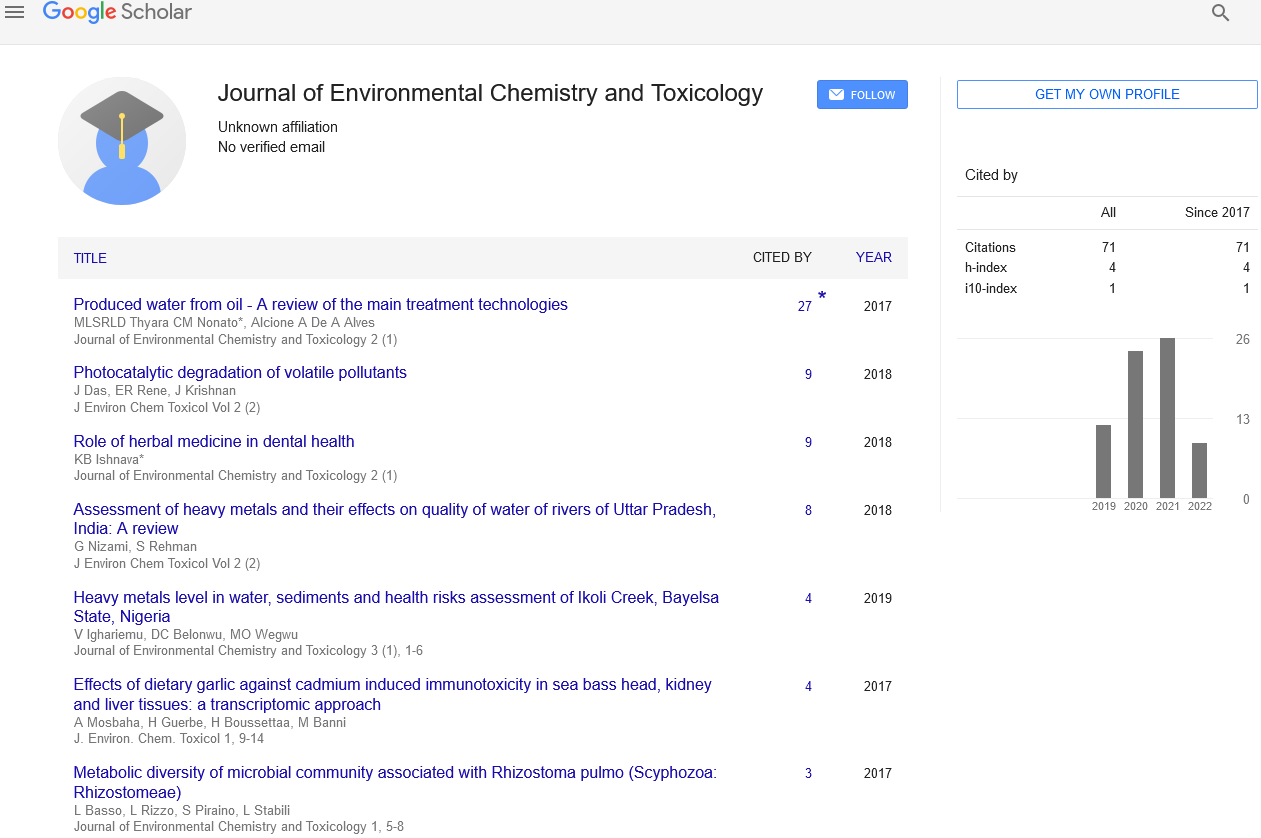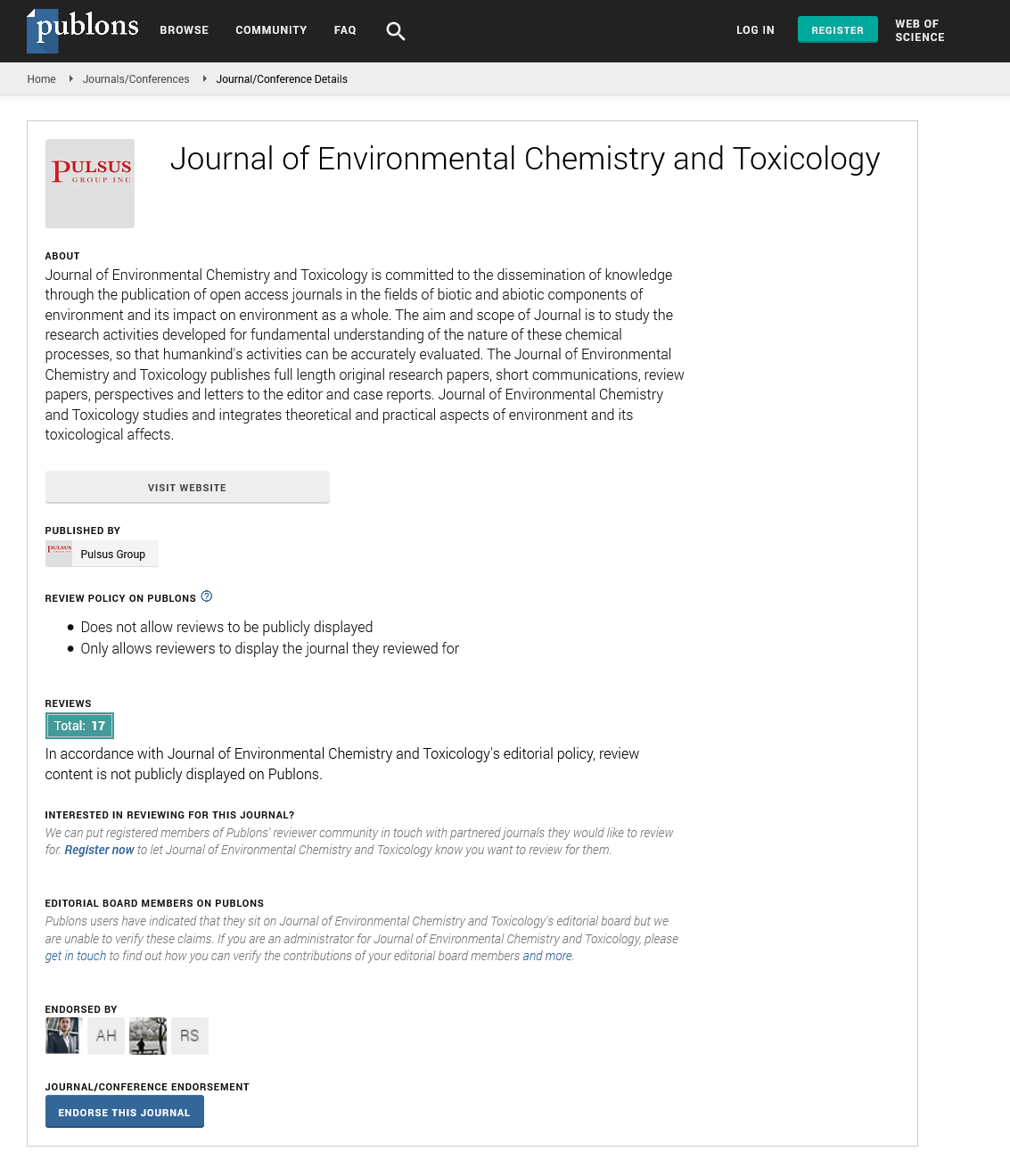Soil biodiversity in the anthropocene: Challenges and opportunities
Received: 04-Mar-2022, Manuscript No. PULJECT-22-4461; Editor assigned: 12-Mar-2022, Pre QC No. PULJECT-22-4461(PQ); Accepted Date: Mar 18, 2022; Reviewed: 14-Mar-2022 QC No. PULJECT-22-4461(PQ); Revised: 16-Mar-2022, Manuscript No. PULJECT-22-4461(R); Published: 24-Mar-2022, DOI: 10.37532/pulject.2022.6(2);14-15
Citation: Thomson L. Soil biodiversity in the anthropocene: challenges and opportunities. J Environ Chem Toxicol. 2022; 6(2):14-15
This open-access article is distributed under the terms of the Creative Commons Attribution Non-Commercial License (CC BY-NC) (http://creativecommons.org/licenses/by-nc/4.0/), which permits reuse, distribution and reproduction of the article, provided that the original work is properly cited and the reuse is restricted to noncommercial purposes. For commercial reuse, contact reprints@pulsus.com
Abstract
Human changes to the environment have a significant impact on Earth’s biodiversity. Although the majority of studies have focused on aboveground biodiversity, little is known about whether biodiversity changes belowground follow the same patterns as aboveground. Direct human actions such as soil sealing, agricultural land-use intensification, and biological invasions caused by the introduction of non-native species have all been shown to have a significant impact on soil biota populations. Abiotic conditions that have changed as a result of climate change have also had an impact on soil biodiversity.
Introduction
Changes in soil biodiversity can affect how the soil biota performs ecosystem functions; hence human-induced global changes have a feedback impact on ecosystem services via changing soil biodiversity. The principal threats to soil biodiversity are highlighted in this article. We also offer suggestions for reversing the reduction in soil biodiversity. We propose that protecting soil biodiversity as a rich reservoir that provides insurance against the Anthropocene's changes is critical. Overall, we need to learn more about the factors that influence soil biodiversity and how they work, develop strategies to prevent further losses, and restore soil biodiversity when possible. The preservation of this diverse biotic pool is critical for the long-term viability of soils and, eventually, human civilization During the Anthropocene, a significant portion of natural land has been converted into human-influenced biomes, which today account for nearly 75% of all land on Earth. The everincreasing human population, along with an ever-increasing ecological footprint per capita, is putting even more strain on the remaining natural area. In addition, the Earth's climate is changing faster than ever before: extreme occurrences such as drought and severe storms are becoming more common, and invasions of new foreign organisms that can affect entire ecosystems are becoming more common. These anthropogenic alterations have far-reaching consequences for all types of species on the globe, with total species diversity declining at a rate 1,000 times faster than it was before humans arrived. Decreases in biodiversity could have serious consequences. The fact that the global biomass of livestock has grown to more than ten times that of all wild mammals and birds combined exemplifies such biodiversity reductions. So far, scientific researchers and the general public have been almost totally focused on macroscopic plants and animals, both in the water and on land. Despite the fact that microscopic creatures and animals living in soils make up the majority of the living biomass on Earth, little is known about anthropogenic consequences on their variety. Soil biodiversity plays a critical role in delivering crucial ecosystem processes and services, despite the fact that the exact mechanisms are largely unknown. As a result, a loss in soil biodiversity is linked to a decrease in numerous soil functions at the same time. The composition and functions of soil biota are becoming better understood, thanks to innovative approaches like high-throughput sequencing. Is there anything we're missing out on as we learn more about soil biodiversity? Yes, soil contains an unknown repertoire of organisms involved in biochemical nutrient cycling, such as the global carbon cycle, as well as other ecosystem processes and services. As a result, soil biota is directly implicated in climate change-related activities, such as the regulation of temperature. However, the soil biota is home to a number of harmful plant and animal pests. Human influences on the environment may modify the physiological activity of the soil biota, amplifying their contributions to global warming, pest outbreaks, and other soil-borne ecosystem services. Soil biodiversity presents a wealth of options, including serving as a reservoir for novel antibiotics, bio control agents, and bio fertilizers, as well as providing a variety of other ecosystem services. We need to learn a lot more about the complex ecosystems of the soil in order to make use of this vast biotic reservoir and offset negative anthropogenic changes that threaten belowground biodiversity. Understanding, conserving, and utilizing soil biodiversity, we think, will be major difficulties in the future.
Soil biodiversity in a nutshell
Plants hold the majority of biotic carbon on Earth (450 gigatons), whereas soil biota holds the second largest pool (approximately 92 gigatons when includes subsoils) . This huge reservoir of biotic carbon tied up in the soil prevents carbon from entering the atmosphere, but also sustains extensive food chains, as a single gramme of soil harbours millions of microorganisms and dozens of tiny invertebrate species . Bacteria, fungi, and their protest predators, as well as a wide range of animals ranging in size from tens of micrometer’s in the case of nematodes to metres in the case of earthworms or mammals such as foxes and badgers that spend part of their lives in soils, are all part of this diversity. An Armillaria fungus, the world's largest creature, is totally soilborne: its size is equivalent to over 1,000 football (both American football and soccer) fields. The soil community contains major decomposers that play important roles in carbon and nutrient
cycle. Pathogens, parasites, and mutualists in the soil can influence plant performance directly, affecting the performance of aboveground biota. Although our knowledge of soil biodiversity is growing, the taxonomic diversity of the soil biota remains unknown, and most soil organisms, particularly microorganisms (viruses, bacteria, fungi, and protists), lack ecological functioning at high taxonomic resolution, such as at the species level. Despite the functional relevance of soil biodiversity for major soil activities and ecosystem services-such as provisioning of clean drinking water, suppression of greenhouse gas generation, and control of illnesses-soil organisms are not frequently included in soil quality assessments and biodiversity reductions are not included in Earth-system models. We can better grasp the value of soil biodiversity on a global scale if we consider and integrate soil biodiversity into large-scale analysis and models. Physical and chemical soil features, as well as interactions with other soil and aboveground biota, such as plants, shape soil biodiversity. On local, regional, and global scales, soil type, pH, carbon and nutrient levels, and soil moisture determine the structure of soil biodiversity. Plants, on the other hand, alter soil biodiversity, frequently in species-specific ways, and trophic, competitive, facilitative, and other forms of interactions between soil organisms influence the overall structure of soil biodiversity.
Soil biodiversity and anthropogenic impacts
Because the soil biota is so reliant on the surrounding abiotic and biotic environment, it is extremely vulnerable to anthropogenic alterations. These changes are linked to the rapid development of the human population and the sealing of an increasing part of the land surface to construct cities and other infrastructure: every year, an area of open soil the size of Berlin gets sealed in the European Union alone. Land is also being taken for mining activities in order to provide us with energy, as well as agricultural in order to provide food, feed, and bioenergy. By 2050, roughly one billion hectares of land might be converted to agriculturally managed land for food production alone. In addition, agricultural practices are changing. Intensified to meet the demands of an ever-increasing human population. Irrigation, the use of heavy machinery, and the increasing application of chemical fertilizers and pesticides are all important aspects of intensified agriculture. These practices alter habitats, changing soil structure and physicochemical properties in the process. This, together with changes in plant biodiversity, has an impact on and typically reduces soil biodiversity. As such, microbial communities are becoming bacteria-dominated, whereas earthworms are killed and mycorrhizal fungi disrupted by soil tillage and other agricultural practices. Agricultural soil land-use intensification, pesticide use, such as neonicotinoids, and herbicides like glyphosate, which can persist in soils for years and harm non-target organisms, are all potential threats to soil biodiversity. Neonicotinoids have a lot of non-target effects because they're supposed to kill bugs. Although they can cause aboveground insect decreases, they can also kill soil invertebrates such as insects and earthworms. Heavy metal contamination from agricultural activities, as well as run-off pollution from mines and smelters, can kill microbial species and alter the makeup of soil communities.






